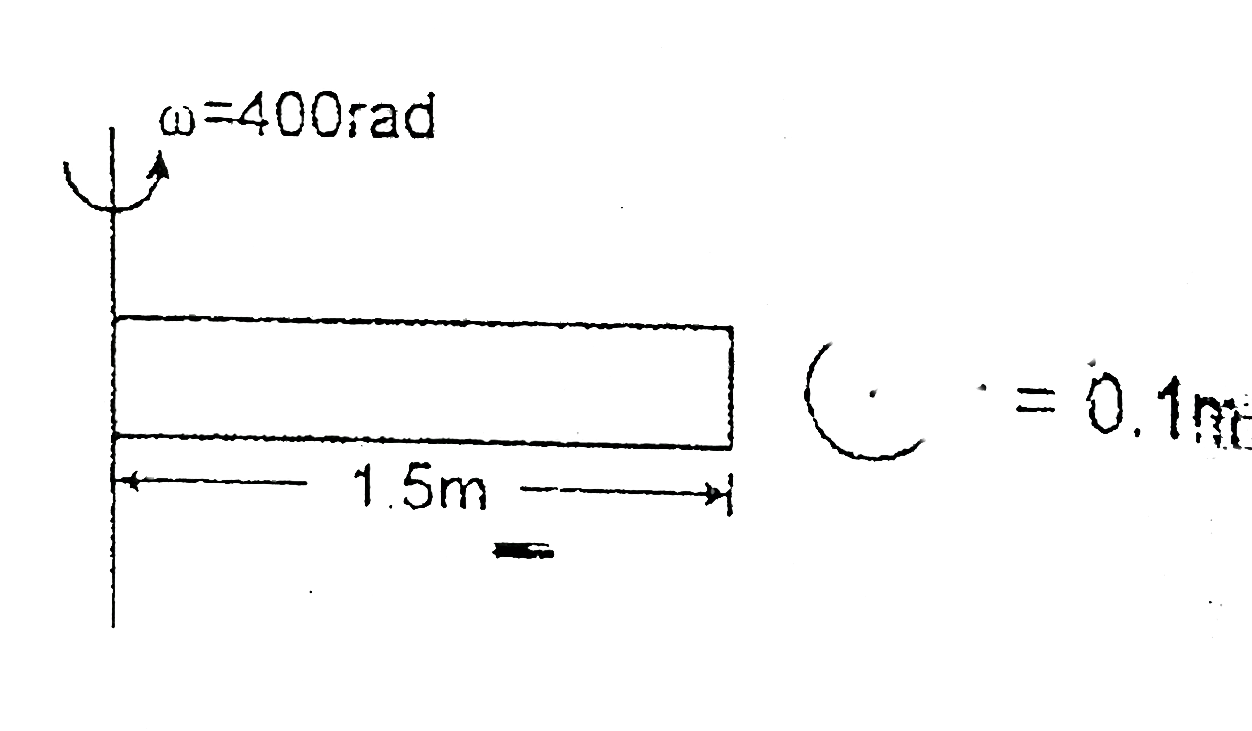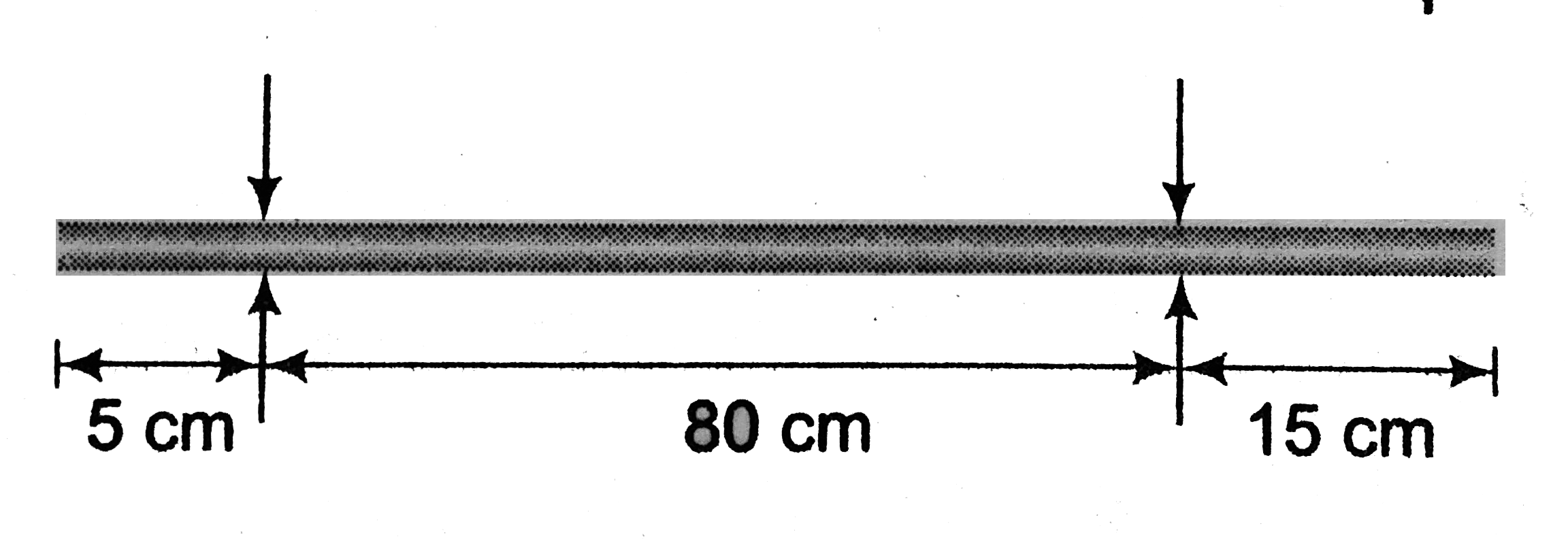A metallic rod of length 1m has one end free and other end rigidly clamped. Longitudinal stationary waves are set up in the rod in such a way that there are total six antinodes present along the rod. The amplitude of an antinode is 4×10−6m. young's modulus and density of the rod are 6.4×1010N/m2 and 4×103Kg/m3 respectively. Consider the free end to be at origin and at t=0 particles at free end are at positive extreme.
The equation describing displacements of particles about their mean positions is.
s−4×106cos(11π2x)cos(22π×103t)
s=4×10−6cos(11π2x)sin(22π×103t)
s=4×10−6cos(5πx)cos(20π×103t)
s=4×10−6cos(5πx)sin(20π×103t)
The correct Answer is:A
To find the equation describing the displacements of particles about their mean positions in a metallic rod with longitudinal stationary waves, we can follow these steps:
Step 1: Understand the Setup
We have a metallic rod of length L=1m with one end free and the other end clamped. There are 6 antinodes present along the rod. The amplitude of the antinode is given as A=4×10−6m.
Step 2: Determine the Wavelength
In a rod with n antinodes, the relationship between the number of antinodes and the wavelength λ is given by:
L=nλ2
For n=6:
L=6λ2⟹λ=2L6=L3=13m
Step 3: Calculate the Speed of the Wave
The speed of longitudinal waves in the rod can be calculated using the formula:
v=√Yρ
where Y is the Young's modulus and ρ is the density of the rod. Given:
- Y=6.4×1010N/m2
- ρ=4×103kg/m3
Calculating the speed:
v=√6.4×10104×103=√1.6×107≈4000m/s
Step 4: Calculate the Frequency
The frequency f can be calculated using the relationship:
f=vλ
Substituting the values:
f=400013=12000Hz
Step 5: Determine the Wave Number k
The wave number k is given by:
k=2πλ
Substituting the value of λ:
k=2π13=6πm−1
Step 6: Determine Angular Frequency ω
The angular frequency ω is related to the frequency by:
ω=2πf
Calculating ω:
ω=2π×12000≈24000πrad/s
Step 7: Write the Equation of the Stationary Wave
The general form of the equation of a stationary wave is:
y(x,t)=Acos(kx)sin(ωt+ϕ)
Given that at t=0, the particles at the free end (origin) are at their positive extreme, we have ϕ=π2.
Thus, the equation becomes:
y(x,t)=4×10−6cos(6πx)sin(24000πt+π2)
Using the identity sin(θ+π2)=cos(θ):
y(x,t)=4×10−6cos(6πx)cos(24000πt)
Final Equation
The final equation describing the displacements of particles about their mean positions is:
y(x,t)=4×10−6cos(6πx)cos(24000πt)
---
We have a metallic rod of length L=1m with one end free and the other end clamped. There are 6 antinodes present along the rod. The amplitude of the antinode is given as A=4×10−6m.
In a rod with n antinodes, the relationship between the number of antinodes and the wavelength λ is given by:
L=nλ2
For n=6:
L=6λ2⟹λ=2L6=L3=13m
The speed of longitudinal waves in the rod can be calculated using the formula:
v=√Yρ
where Y is the Young's modulus and ρ is the density of the rod. Given:
- Y=6.4×1010N/m2
- ρ=4×103kg/m3
v=√6.4×10104×103=√1.6×107≈4000m/s
The frequency f can be calculated using the relationship:
f=vλ
Substituting the values:
f=400013=12000Hz
The wave number k is given by:
k=2πλ
Substituting the value of λ:
k=2π13=6πm−1
The angular frequency ω is related to the frequency by:
ω=2πf
Calculating ω:
ω=2π×12000≈24000πrad/s
The general form of the equation of a stationary wave is:
y(x,t)=Acos(kx)sin(ωt+ϕ)
Given that at t=0, the particles at the free end (origin) are at their positive extreme, we have ϕ=π2.
y(x,t)=4×10−6cos(6πx)sin(24000πt+π2)
y(x,t)=4×10−6cos(6πx)cos(24000πt)
The final equation describing the displacements of particles about their mean positions is:
y(x,t)=4×10−6cos(6πx)cos(24000πt)
Topper's Solved these Questions
Similar Questions
A metallic rod of length 1m has one end free and other end rigidly clamped. Longitudinal stationary waves are set up in the rod in such a way that there are total six antinodes present along the rod. The amplitude of an antinode is 4×10−6m. young's modulus and density of the rod are 6.4×1010N/m2 and 4×103Kg/m3 respectively. Consider the free end to be at origin and at t=0 particles at free end are at positive extreme.
The equation describing stress developed in the rod isView SolutionA metallic rod of length 1m has one end free and other end rigidly clamped. Longitudinal stationary waves are set up in the rod in such a way that there are total six antinodes present along the rod. The amplitude of an antinode is 4×10−6m. young's modulus and density of the rod are 6.4×1010N/m2 and 4×103Kg/m3 respectively. Consider the free end to be at origin and at t=0 particles at free end are at positive extreme.
The magnitude of strain at midpoint of the rod at t=1sec isView SolutionA metallic rod of length 1m is rigidly clamped at its mid point. Longirudinal stationary wave are setup in the rod in such a way that there are two nodes on either side of the midpoint. The amplitude of an antinode is 2×10−6m. Write the equation of motion of a point 2 cm from the midpoint and those of the constituent waves in the rod, (Young,s modulus of the material of the rod =2×1011Nm−2 , density =8000kg−m−3). Both ends are free.
View SolutionCalculate the speed of longitudinal wave in steel. Young's modulus for steel is 3×1010N/m2 and its density 1.2×103kg/m3
View SolutionCalculate the speed of longitudinal wave in steel. Young's modulus for steel is 3×1010N/m2 and its density 1.2×103kg/m3
View SolutionA rod of nickel of length l is clamped at its midpoint . The rod is stuck and vibrations are set up in the rod . Find the general expression for the frequency of the longitudinal vibrations of the rod . Young's modulus and density of the rod is Yandρ , respectively.
View SolutionA metallic rod of length 1 m, young's modulus 3×1011Nm−3 and density is 7.5×102kgm3clamped at its middle. Longitudinal stationary vibrations are produced in the rod with the total number of displacement nodes equal to 3. The frequency of vibrations is
View SolutionGiven Y=2×1011N/m2,ρ=104kg/m3
Find out elongation in rod.
 View Solution
View SolutionA metal rod of length 1m is clamped at two points as shown in the figure. Distance of the clamp from the two ends are 5 cm and 15 cm, respectively. Find the minimum and next higher frequency of natural longitudinal oscillation of the rod. Given that Young's modulus of elasticity and density of aluminium are Y=1.6×1011Nm−2 and ρ=2500kgm−3 , respectively.
 View Solution
View SolutionThe Young's modulus of brass is 9.1×1010N/m2and its rigidity modulus is 3.5×1010N/m2. Calculate its Poisson's ratio ?
View Solution

